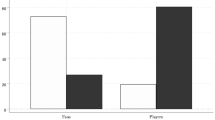Abstract
Composing a team of professional players is among the most crucial decisions in association football. Nevertheless, transfer market decisions are often based on myopic objectives and are questionable from a financial point of view. This paper introduces a chance-constrained model to provide analytic support to club managers during transfer windows. The model seeks a top-performing team while adapting to different budgets and financial-risk profiles. In addition, it provides a new rating system that is able to numerically reflect the on-field performance of football players and thus contribute to an objective assessment of football players. The model and rating system are tested on a case study based on real market data. The data from the case study are available online for the benefit of future research.










Similar content being viewed by others
References
Charnes A, Cooper WW (1959) Chance-constrained programming. Manag Sci 6(1):73–79
Dendir S (2016) When do soccer players peak? A note. J Sports Anal 2:89–105
Dobson S, Goddard J (2001) The economics of football. Cambridge University Press, Cambridge
Hvattum L (2019) A comprehensive review of plus-minus ratings for evaluating individual players in team sports. Int J Comput Sci Sport 18(1):1–23. https://doi.org/10.2478/ijcss-2019-0001
Il Sole 24 Ore (2018) Juventus e Amplifon verso l’ingresso nel Ftse Mib, 2018. https://www.ilsole24ore.com/art/finanza-e-mercati/2018-12-06/juventus-e-amplifon-l-ingresso-ftse-mib-075333.shtml?uuid=AEiV30tG. Accessed 6 Dec 2018
Kaut M, Wallace SW (2007) Evaluation of scenario-generation methods for stochastic programming. Pac J Optimi 3(2):257–271
Késenne S (1996) League management in professional team sports with win maximizing clubs. Eur J Sports Manag 2:14–22
Késenne S (2006) The objective function of a team. In: Andreff W, Szymanski S (eds) Handbook on the economics of sport. Edward Elgar, Cheltenham, pp 601–609
Kleywegt A J, Shapiro A, Homem-de Mello T (2002) The sample average approximation method for stochastic discrete optimization. SIAM J Optim 12(2):479–502
KPMG (2017) Football clubs and the stock exchange in 2016 . https://www.footballbenchmark.com/stock_exchange_football_clubs. Accessed 6 Dec 2018
Kuper S, Szymanski S (2018) Soccernomics. Nation Books, New York
Lewis M (2004) Moneyball: the art of winning an unfair game. W.W.Norton & Company, New York
Macdonald B (2012a) Adjusted plus-minus for NHL players using ridge regression with goals, shots, Fenwick, and Corsi. J Quant Anal Sports. https://doi.org/10.1515/1559-0410.1447
Pagnoncelli BK, Ahmed S, Shapiro A (2009) Sample average approximation method for chance constrained programming: theory and applications. J Optim Theory Appl 142(2):399–416
Pantuso G (2017) The football team composition problem: a stochastic programming approach. J Quant Anal Sports 13(3):113–129
Payyappalli V, Zhuang J (2019) A data-driven integer programming model for soccer clubs’ decision making on player transfers. Environ Syst Decis 39:466–481
Rascher D (1997) A model of a professional sports league. In: Hendricks W (ed) Advances in the economics of sport, vol 2. JAI Press, London, pp 27–76
Sæbø O, Hvattum L (2015) Evaluating the efficiency of the association football transfer market using regression based player ratings. In: NIK: Norsk Informatikkonferanse. Bibsys Open Journal Systems
Sæbø O, Hvattum L (2019) Modelling the financial contribution of soccer players to their clubs. J Sports Anal 5:23–34
Shapiro A (2003) Monte Carlo sampling methods, Chap 5. In: Handbooks in operations research and management science, vol 10. Elsevier, pp 353–425
Sill J (2010) Improved NBA adjusted +/– using regularization and out-of-sample testing. In: Proceedings of the 2010 MIT sloan sports analytics conference
Sloane P (1971) The economics of professional football: the football club as a utility maximizer. Scottish J Polit Econ 17:121–146
Szczepański Ł (2015) Assessing the skill of football players using statistical methods. Ph.D. thesis, Salford Business School, University of Salford, Salford
UEFA (2018) Club licensing benchmarking report: financial year 2016. https://www.uefa.com/MultimediaFiles/Download/OfficialDocument/uefaorg/Clublicensing/02/53/00/22/2530022_DOWNLOAD.pdf. Accessed 10 Nov 2018
Vanguard (2018) Juventus shares to be added to Italy’s FTSE-Mib index. https://www.vanguardngr.com/2018/12/juventus-shares-to-be-added-to-italys-ftse-mib-index/. Accessed 10 Nov 2018
Winston W (2009) Mathletics. Princeton University Press, Princeton
Acknowledgements
The authors wish to thank two anonymous reviewers, whose comments helped to improve the contents and presentation of this manuscript.
Author information
Authors and Affiliations
Corresponding author
Additional information
Publisher's Note
Springer Nature remains neutral with regard to jurisdictional claims in published maps and institutional affiliations.
Sensitivity to the formation
Rights and permissions
About this article
Cite this article
Pantuso, G., Hvattum, L.M. Maximizing performance with an eye on the finances: a chance-constrained model for football transfer market decisions. TOP 29, 583–611 (2021). https://doi.org/10.1007/s11750-020-00584-9
Received:
Accepted:
Published:
Issue Date:
DOI: https://doi.org/10.1007/s11750-020-00584-9





